Social Media Timing: The Ultimate Guide to Boosting Engagement
Updated On: October 23, 2025 by Aaron Connolly
Understanding Social Media Timing Fundamentals
Nailing your timing on social media really can mean the difference between a post blowing up or just vanishing without a trace.
A few big factors shape your best posting times: platform algorithms, your audience’s habits, and what kind of content you’re sharing at certain hours.
Why Social Media Timing Matters
When you post at the right moment, more people see and engage with your content.
If you hit those peak hours, your post lands higher in people’s feeds and grabs more eyeballs.
Digital marketing relies on visibility, plain and simple.
If you post during quiet times, your stuff gets buried under a wave of new content before anyone even logs in.
Engagement patterns aren’t random—they spike and drop at pretty predictable times.
You’ll catch people scrolling during their morning commute, usually 7-9 AM.
Lunch breaks, from 11 AM to 1 PM, are perfect for quick, snackable posts.
Evenings, say 6-8 PM, are prime for longer reads or videos, since folks actually have time to hang out online.
Key timing benefits:
- Higher organic reach
- More likes, comments, and shares
- Better algorithm performance
- Smarter ad spend
If you post at the wrong time, all that effort goes to waste.
Even the best content struggles to get noticed if it drops during a lull.
Impact of Algorithms on Visibility
Algorithms care a lot about timing when they decide what to show people.
That first hour after you post? It’s crucial for engagement and long-term reach.
Instagram loves recent posts, so timing seriously matters for getting noticed.
If you post when your audience is active, you grab quick engagement, and the algorithm rewards you by pushing your post further.
Facebook looks at engagement over several hours, but early comments and shares still give you an edge.
LinkedIn is a different beast—it follows workday rhythms, so posting during business hours (8-10 AM, 12-1 PM, 5-6 PM) works best.
Algorithm factors:
- Recency—newer posts get attention
- Early engagement—fast likes and comments push your reach
- Time zone targeting—platforms check where your users live
- Past timing performance—your previous timing successes impact future reach
If you get how these systems tick, you can work with them instead of fighting against the current.
Audience Habits and Behaviour
Your own followers’ routines matter way more than any industry average.
Engagement patterns shift a lot depending on age, location, and what your brand actually does.
B2B brands see action during work hours and lunch.
B2C and lifestyle brands? Evenings and weekends usually win, since people are off the clock.
Audience behaviour factors:
- Age groups—Gen Z is active at totally different times than millennials
- Where your fans live—if you’ve got global followers, you need a wider posting window
- Work schedules—remote workers aren’t always online at classic office hours
- Content type—educational stuff works in the morning, fun or entertainment later in the day
Honestly, your best bet is to check your own analytics.
See when your followers are most active, and focus on those windows.
Track engagement by hour and day for a few weeks.
Look for the patterns that keep coming back.
Let your audience’s habits guide your schedule instead of just copying what everyone else does.
Key Benefits of Posting at the Right Time
If you get your posting schedule right, you can boost engagement by as much as 20%.
The difference between posting at peak times and off-hours? Sometimes it’s thousands of extra views.
Maximising Engagement Opportunities
Every platform has its own “sweet spot” for engagement.
If you hit those windows, you get way more likes, comments, and shares.
When you post during high-traffic periods, your stuff pops up when people are actually around and ready to interact.
LinkedIn gets busy during work hours, from 7am to 4pm.
TikTok, though, really comes alive in the evening when everyone’s just chilling and scrolling for fun.
Morning posts usually pull in about 8.8% more engagement.
That’s because algorithms love fresh content, and early posts have more time to rack up momentum.
You want to match your content to your audience’s habits.
Business or educational posts do well during commutes; entertainment stuff shines in the evening.
If you post consistently at the best times, your followers start expecting new content and are more likely to check in.
Increasing Reach and Impressions
When you time your posts right, more people see them—simple as that.
Posting at peak hours can bump your reach by 23% compared to quiet times.
Algorithms favour new, engaging content, so if you get quick likes and comments, your post gets shown to even more people.
Weekend posts usually see 10-15% less reach, so weekdays are where you want to focus, especially for business content.
If your audience is global, think about their time zones.
You might need to post more than once or schedule posts to hit different regions.
Every platform has its own prime time.
Instagram does best between 3-6pm on weekdays.
Facebook? Oddly, it’s 5-7am.
Knowing these quirks helps you get the most eyes on your posts.
Driving Traffic and Conversions
If you post at the right time, you’ll see 11.1% higher click-through rates.
That means more people actually visit your site, sign up, or buy something.
Peak engagement times are magic for conversions.
When people are in the mood to scroll and interact, they’re way more likely to click your links and follow your calls-to-action.
Digital marketing campaigns just work better when your timing lines up with when your audience is active.
Higher engagement means you get more organic reach, so you don’t have to spend as much on ads.
LinkedIn drives more B2B traffic during work hours.
Consumer platforms do better in the evenings, when people are off work.
If you post regularly at the best times, you build trust and your followers know when to expect new stuff.
That keeps your brand top-of-mind when they’re ready to make a move.
Factors Influencing Optimal Posting Times
Your perfect posting time isn’t just guesswork.
It depends on a mix of things like your audience’s time zones, your industry, who actually follows you, and what’s going on seasonally.
If you figure out these details, you’ll find your best shot for engagement.
Audience Time Zones
Time zones make a massive difference in timing.
If your followers are spread out, you’ve got to think about when each group is awake and online.
Most brands focus on their biggest audience first.
For example, a UK esports team might post at 7 PM GMT to catch local fans after work.
Global teams often post twice—once for Europe, once for North America.
Multi-timezone strategies:
- Post the same thing 6-8 hours apart
- Aim for overlapping active hours (like 2-4 PM GMT)
- Tailor content for each region
Gaming communities are especially international.
You might have fans in Asia, Europe, and the US all following the same updates.
Check your analytics to see where your followers actually live.
Instagram and Facebook make this pretty easy.
Put most of your focus (around 70%) on your main audience, and the rest on secondary regions.
Industry-Specific Trends
Every industry has its own rhythm.
What works for fashion brands definitely won’t work for gaming content.
Esports and gaming do best:
- After school or work (4-7 PM)
- During evening gaming hours (7-11 PM)
- Weekend mornings (9 AM-12 PM)
B2B content gets attention during business hours.
Entertainment content pulls more engagement in the evenings.
News spreads fastest in the morning.
Gaming-specific tips:
- Announce tournaments on weekday evenings
- Drop match highlights right after games
- Share interviews or behind-the-scenes stuff between matches
Your content type matters, too.
Short clips work during quick breaks.
Longer videos need evening slots when people have time to watch.
Demographics and Lifestyle
Age, work, and lifestyle all change when people use social media.
Age-based patterns:
- 13-18 year olds: After school (3-6 PM) and late at night (9-11 PM)
- 18-25 year olds: Lunch (12-2 PM) and evening (7-10 PM)
- 25-35 year olds: Morning commute (7-9 AM) and after work (6-8 PM)
- 35+: Evenings (6-9 PM) and weekend mornings
Students check in between classes and after homework.
Professionals browse during breaks or commutes.
Parents often scroll once the kids are asleep.
Gaming fans tend to be night owls.
Many are most active from 8 PM to midnight, and weekend sessions can go even later.
Think about your followers’ daily routines.
University students and office workers aren’t online at the same times.
Streamers keep different hours than casual players.
Seasonality and Cultural Impact
Seasons, holidays, and major events totally shake up engagement patterns.
Gaming communities especially see big changes depending on what’s happening.
Gaming season trends:
- Summer: Younger fans are online during the day
- School term: More activity after school and in the evenings
- Big game releases: Engagement spikes across the board
- Tournament season: Highest engagement during finals and big matches
Holidays flip everything.
Christmas week looks nothing like a normal week.
Huge gaming events like E3 or The International create big surges.
Cultural timing tips:
- Ramadan: Evening engagement peaks later in Muslim-majority countries
- Chinese New Year: Asian activity shifts a lot
- School holidays: Teens are online at odd hours
- Major sports events: Gaming content competes with traditional sports
Back-to-school in September changes everything for younger fans.
Summer camps and events shift when competitive players are around.
Watch your analytics during different seasons.
What works in January might flop in July.
General Best Times to Post on Social Media
Most platforms see peak engagement from 10 a.m. to 1 p.m. on weekdays.
Wednesday usually comes out on top.
But honestly, morning, afternoon, and evening posts all play their own role in your strategy.
Morning Posting Windows
Mornings get some of the best engagement.
People roll over, grab their phones, and check what’s new.
Facebook hits its stride between 8-11 a.m.
People sip coffee and scroll before work kicks in.
Instagram is strong from 9-11 a.m.
That’s when people are commuting or grabbing breakfast.
Morning posts work especially well for:
- News and updates
- Motivational quotes or tips
- Announcements
You’ll often see more comments and shares in the morning.
People just have a bit more time before their day gets crazy.
Quick tip: Try posting your top content on Tuesday or Wednesday mornings, around 9-10 a.m.
Afternoon Engagement Peaks
Afternoons, from noon to 3 p.m., are another solid window.
You catch people on lunch or sneaking a social break at work.
TikTok really pops off in the afternoon, especially 2-5 p.m.
Users love watching quick videos during downtime.
LinkedIn is busiest from 10 a.m. to 1 p.m. on weekdays.
Business folks check in during work hours.
Afternoon is perfect for:
- Educational posts
- Behind-the-scenes looks
- Polls and questions
Pinterest is a bit different—it peaks at 1 p.m. every day.
People look for inspiration during lunch.
The afternoon window grabs both work break scrollers and students just getting home.
Evenings and Night-time Posting
Evening posts usually get less engagement than morning or afternoon slots. But I’ve noticed some content just works better after 5 p.m.
Entertainment content tends to do well in the evenings, especially when people are winding down after work. Video content and live streams often find their audience between 6-8 p.m.
Weekend evenings are a different story. Saturday mornings (9-11 a.m.) often beat out Saturday nights on most platforms.
Avoid Sunday evenings on every platform. The numbers don’t lie—engagement drops off a cliff.
Evening posting can make sense for:
- Live streams and real-time content
- Entertainment and lifestyle posts
- Community engagement and responses
Warning: Don’t put all your eggs in the evening basket. Morning and afternoon posts usually bring in 2-3 times more engagement.
Always keep your audience’s time zone in mind. Your evening might be someone else’s morning.
Optimal Timing for Each Social Platform
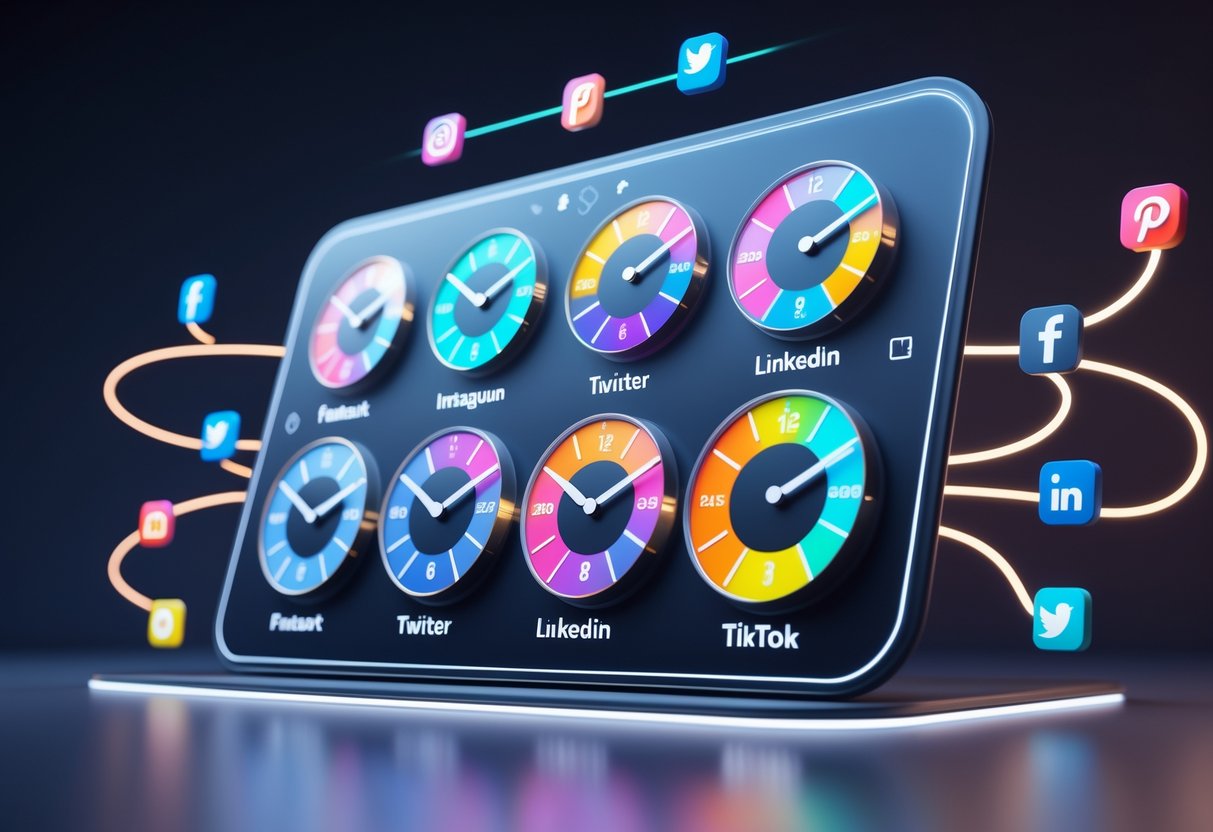
Each social platform has its own engagement quirks and peak times. Audiences are most active at different hours on Facebook than on TikTok, for example.
Facebook Scheduling Insights
Facebook posts get the most attention during morning hours on weekdays. The best results usually happen between 9 a.m. and noon, Monday through Thursday.
Best Facebook posting times:
- Monday-Tuesday: 9 a.m.–noon
- Wednesday: 8–11 a.m. and 3–5 p.m.
- Thursday: 8 a.m.–noon
- Friday: 9–10 a.m.
Weekend engagement falls off. Saturday mornings (9–10 a.m.) show some activity, but Sunday is just plain slow.
Facebook’s audience likes to check their feeds early, often before work or while commuting.
Quick win: Drop your most important Facebook posts between 9–10 a.m. on weekdays for the best shot at visibility.
Instagram Timing Strategies
Instagram’s optimal posting times stretch later into the day than Facebook’s. Peak engagement happens between 10 a.m. and 4 p.m. on weekdays.
Prime Instagram hours:
- Monday & Wednesday: 10 a.m.–4 p.m.
- Tuesday & Thursday: 10 a.m.–2 p.m.
- Friday: 11 a.m. and 2 p.m.
Weekends are a mixed bag. Saturday brings the lowest engagement of the week, while Sunday has short windows at 10 a.m.–noon and 3 p.m.
Instagram’s visual vibe fits with afternoon scrolling. People browse during lunch or afternoon breaks when they have time to check out photos and videos.
Warning: Skip Saturday posts unless you know your audience is there.
X (Twitter) Peak Periods
X keeps engagement steady from mid-morning through early afternoon. The platform’s consistency across weekdays stands out.
Optimal X posting schedule:
- Monday: 10 a.m.–noon
- Tuesday & Thursday: 10 a.m.–2 p.m.
- Wednesday: 9 a.m.–3 p.m.
- Friday: 9 a.m.–1 p.m.
Saturday engagement sticks around until 2 p.m., but Sunday only sees a spike at noon.
People come to X for news and updates during work hours and lunch breaks. That’s when trending topics really take off.
Consistent posting during these windows pays off more than just one daily tweet.
Best Practices for Posting Frequency
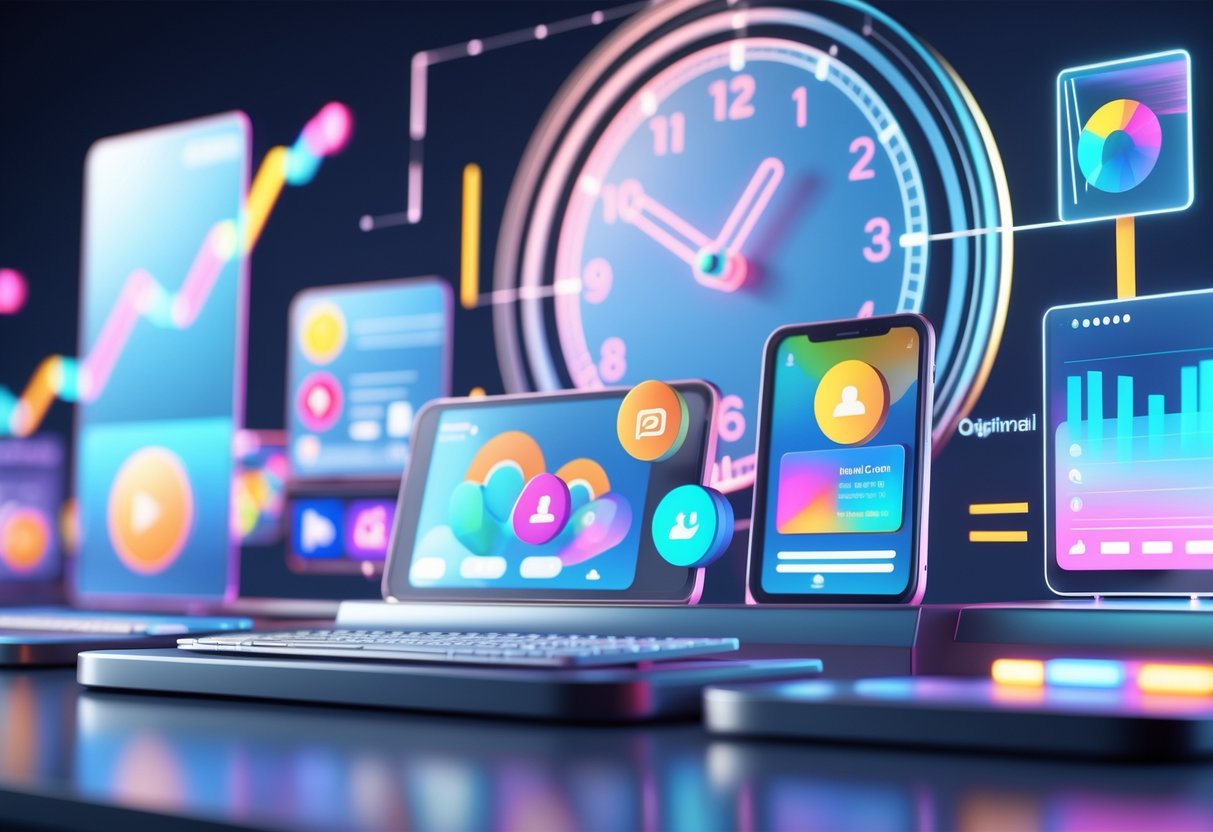
Nailing your posting frequency depends on three things: a schedule your audience can count on, quality content, and matching each platform’s pace.
Establishing a Consistent Calendar
A steady posting schedule builds trust with your esports crowd. Fans expect regular updates on tournaments, players, and game analysis.
Start with a simple weekly calendar. Post match previews on Mondays, highlight reels on Wednesdays, and tournament roundups on Fridays. That rhythm helps people know what to expect.
Weekly posting structure that works:
- Monday: Tournament previews and team news
- Wednesday: Player highlights or gameplay tips
- Friday: Match results and weekend tournament schedules
Track your schedule for a month. Note which days pull in the most engagement and comments. Many esports fans are busiest during evenings and weekends when tournaments happen.
Scheduling tools like Buffer and Hootsuite help you stick to your plan. They let you work around big tournament dates and player news, so you don’t miss a beat during busy seasons.
Balancing Quality with Quantity
Posting a lot means nothing if your content isn’t useful. Two solid, well-researched posts about upcoming matches beat five generic updates any day.
Focus on what your esports community actually wants. Share tactical breakdowns, roster changes, and tournament brackets that give real insight. Nobody needs another vague gaming quote.
High-quality esports content includes:
- Match analysis with examples
- Player interviews or reliable quotes
- Tournament updates with prize info
- Gameplay tips from coaches or pros
Check your content performance often. Posts with deep match stats usually get more attention than simple score updates. Fans stick around for content that teaches them something.
Esports moves fast. One standout post about a big roster change is worth more than a handful of minor league updates.
Adjusting Frequency for Each Platform
Each platform attracts a different slice of the esports world. Twitter users want match updates right now, while LinkedIn readers care more about the business side.
Platform-specific posting recommendations:
- Twitter/X: 2-3 daily posts during tournaments
- Instagram: 3-4 posts weekly with strong visuals
- Facebook: 1-2 daily posts with community focus
- LinkedIn: 1-2 weekly posts on industry trends
- TikTok: 3-5 short highlights or tutorials per week
Twitter is perfect for live tournament coverage and fast reactions. Post results right away, then follow up with deeper analysis. Instagram works best for player spotlights and behind-the-scenes shots.
Check your analytics every month. Esports fans act differently during big events than in the off-season. Post more during tournaments like The International, then slow down when things are quiet.
Test your timing based on where your audience lives. European events need a different schedule than Asian tournaments.
Customising Posting Schedules Using Data
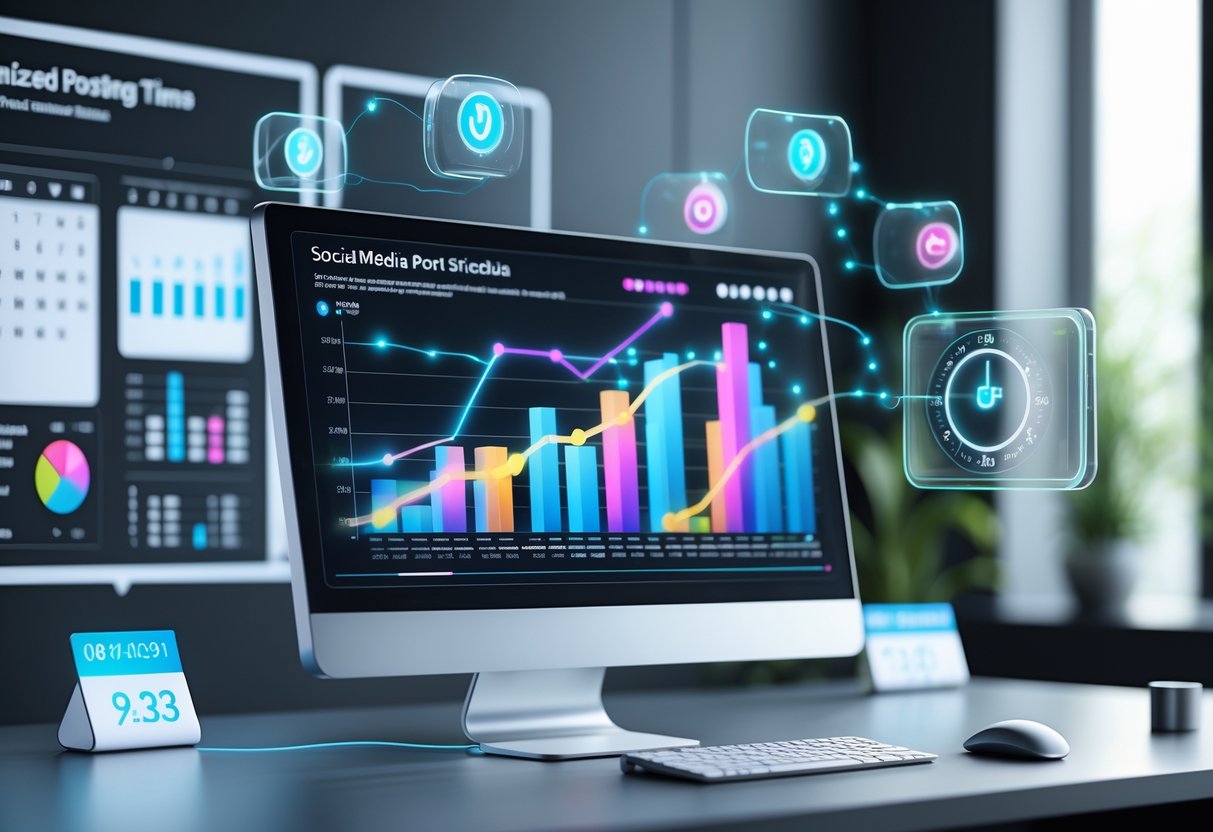
To really nail social media timing, you need to know how your own audience behaves—not just follow generic advice. Dive into your engagement data, use analytics, and test different timings to build a posting schedule that actually works.
Analysing Audience Engagement
Look at your audience’s real habits to figure out the best posting schedule. Engagement stats show you when your followers are most active.
Track these key engagement patterns:
- Top activity hours by day
- How quickly people respond to comments and messages
- Which content gets the most interaction
- Seasonal swings in behaviour
Collect at least four weeks of data before making big changes. That way, you see real patterns instead of flukes.
Don’t just count likes. Comments and shares show deeper engagement, and those happen when people have more time to interact.
Quick win: Set up weekly engagement reports to see trends over time, not just from a single post.
Using Platform Insights
Every platform gives you analytics about when your audience is online. Those numbers are way more useful than industry averages.
Facebook Insights breaks down activity by hour and day. Instagram Analytics shows when your followers scroll and which posts do best at different times.
LinkedIn and X offer their own data, focused on professional or real-time engagement.
Essential metrics to watch:
- When followers are active
- Times with the highest reach and impressions
- Click-through rates by post time
- Shifts in engagement rates
Check these stats every month and tweak your schedule. Posting when your audience is online boosts your chances with the algorithm.
Warning: Don’t just trust platform suggestions blindly. Compare data across months to spot real trends.
Experimenting with Different Times
Testing different times helps you go beyond guesses. Try simple experiments to find your best posting slots.
Pick a platform and test three different times for the same kind of post. Share similar content at different hours over a few weeks.
Track engagement rates, reach, and comments for each slot. Jot down the results in a spreadsheet and see what stands out.
Testing framework:
- Week 1: Post at 9 AM
- Week 2: Post at 1 PM
- Week 3: Post at 6 PM
- Week 4: Repeat the best time
Change only one thing at a time. If you switch content and timing together, you won’t know what made the difference.
Run these tests for at least a month. Some fans are more active on weekdays, others on weekends.
Essential Scheduling Tools for Success
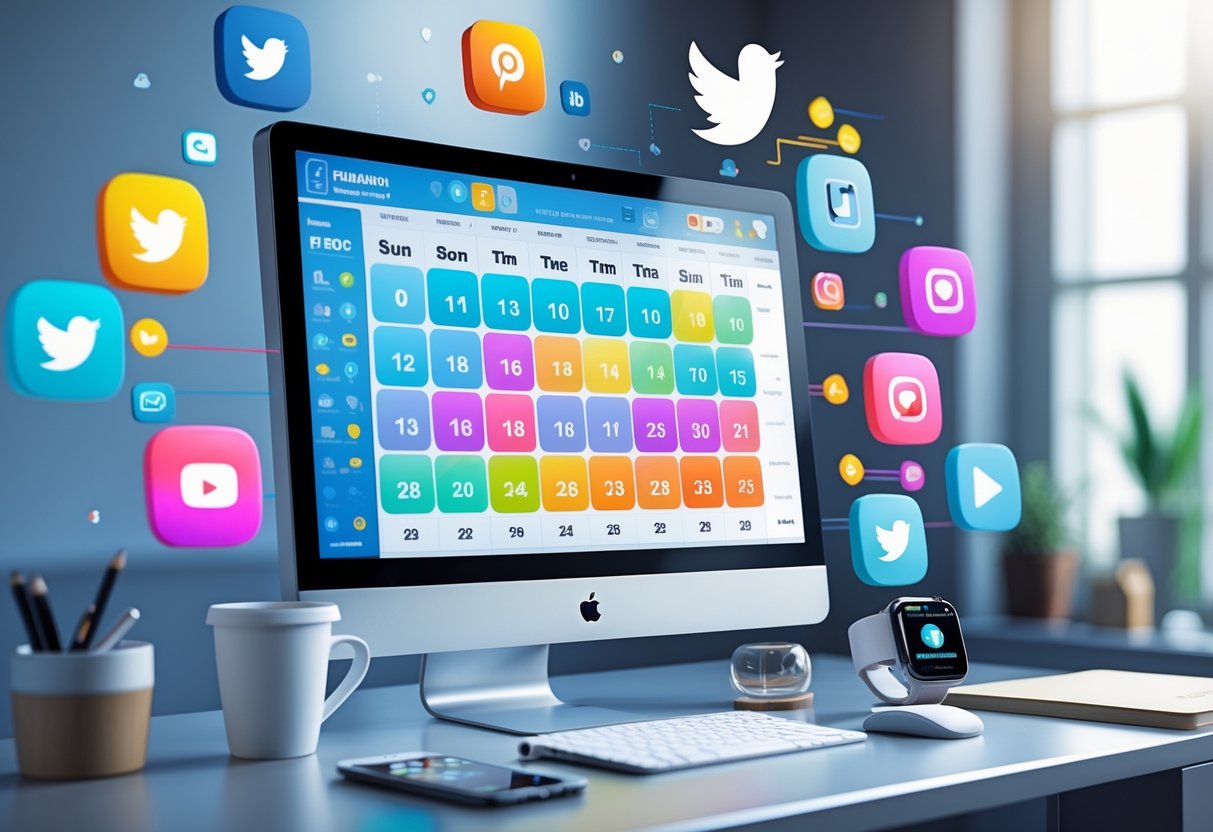
The right scheduling tools can turn your social media timing from a guessing game into a real strategy. Each platform brings something different—analytics insights, cross-platform posting, or just making your workflow smoother.
Sprout Social for Analytics
Sprout Social gives you deep insights into your posting performance. You can see exactly when your audience is most active on each network.
Track engagement rates by hour and day. Find the sweet spots for reach and interaction.
Key Analytics Features:
- Audience activity reports by platform
- Engagement rate tracking by post time
- Compare content performance
- Custom reporting dashboards
It costs around £89 per user each month. Teams with lots of clients or big brands will get the most out of it.
Sprout Social digs deeper than basic stats. You can spot which types of content work best at certain times and tweak your approach.
Hootsuite for Multi-Platform Management
Hootsuite lets you handle all your social accounts from one dashboard. Schedule posts across Facebook, Instagram, Twitter, LinkedIn, and YouTube in one go.
Bulk scheduling is a real time-saver. Just upload a CSV and Hootsuite spreads your posts across platforms and times.
Multi-Platform Benefits:
- One dashboard for all accounts
- Bulk upload
- Team collaboration
- Auto-posting to 35+ networks
Pricing starts at £39 a month for three profiles. The pro plan offers 10 profiles for £129 per month.
Hootsuite shines with complex posting schedules. Plan weeks ahead and keep your presence steady everywhere.
Buffer and Effortless Scheduling
Buffer keeps things simple. The platform suggests the best times to post based on your audience’s habits.
Set up your schedule in minutes. Buffer checks your followers’ behaviour and recommends time slots for max engagement.
Buffer’s Scheduling Features:
- Smart timing suggestions
- Visual content calendar
- Queue management
- Mobile app for posting on the go
The free plan covers three accounts with 10 scheduled posts each. Paid plans start at £5 per social channel monthly.
Buffer’s mobile app makes it easy to post anywhere. Snap a pic, write a caption, and Buffer handles the timing.
Advanced Social Media Automation Solutions
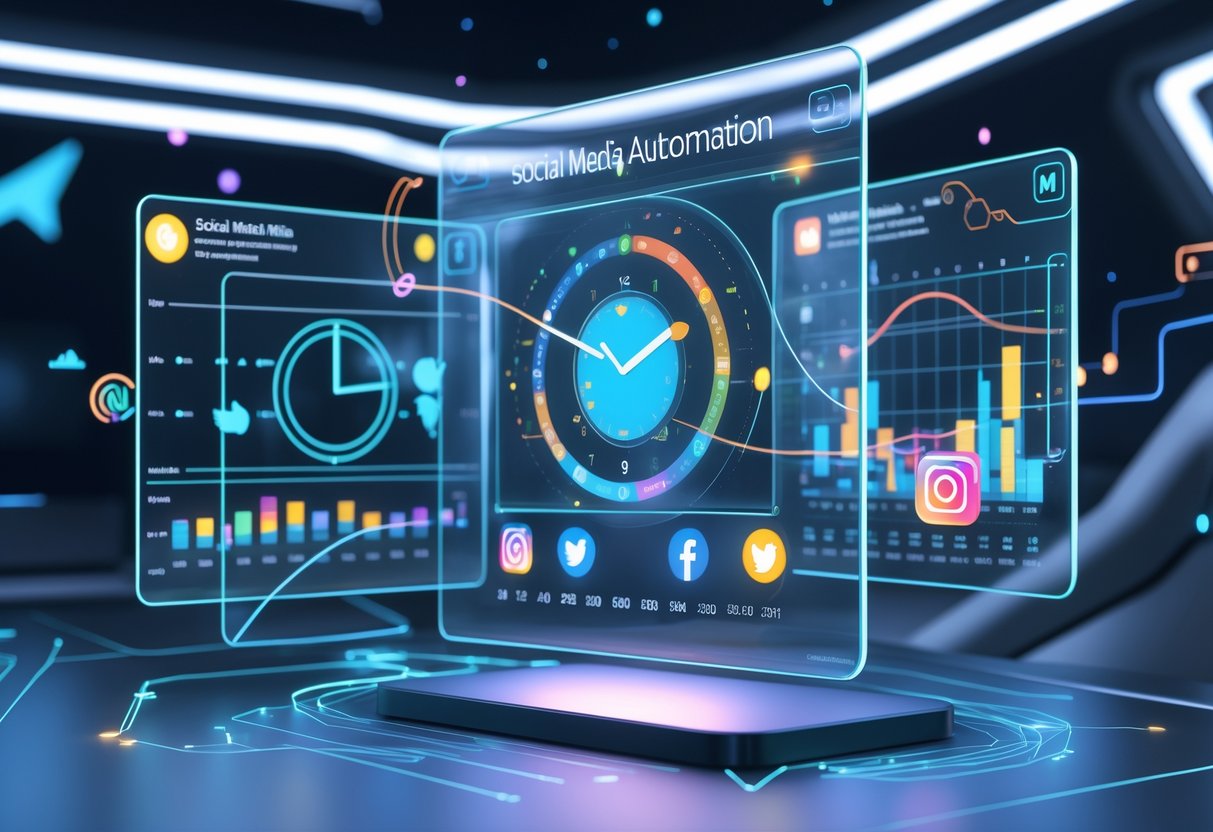
Modern automation tools now offer features that do more than just basic scheduling. Meta Business Suite lets you manage Facebook and Instagram in one place, SocialBee helps you recycle content by category, and integrated campaign tools make it easier to coordinate timing across different platforms.
Utilising Meta Business Suite
Meta Business Suite acts as the main hub for managing Facebook and Instagram accounts. Businesses running paid social campaigns rely on it since it connects directly with Meta’s advertising tools.
You can use the scheduling interface to plan posts weeks ahead for both platforms at once. Customise your content for each platform, but keep your messaging consistent.
Key automation features include:
- Suggestions for the best posting times
- Adapting content for each platform
- Managing ad campaigns in one place
- Tracking performance in real time
The analytics dashboard shows detailed insights about your audience’s engagement patterns. You can use this data to tweak your posting schedule and catch people when they’re most active.
Content collaboration tools let team members review and approve posts before they go live. This keeps your brand consistent and speeds up approvals for bigger teams.
Exploring SocialBee Features
SocialBee stands out with its category-based scheduling system. Instead of sharing content once, it recycles evergreen posts to keep your social channels active.
You can organise your content into categories like promotional posts, blog articles, or industry news. Set a posting schedule for each category, so you get a balanced mix without having to micromanage everything.
Advanced recycling features include:
- Generating variations of your content automatically
- Setting expiry dates for time-sensitive posts
- Spacing out similar posts to avoid repetition
- Creating multiple versions of the same message
Content libraries let you save approved posts, images, and templates for easy reuse. This really helps when you’re juggling several clients or brand channels.
The AI-powered writing assistant creates fresh variations of your posts, so recycled content still feels new to your audience. This keeps people engaged over time.
Integrating Tools Across Campaigns
Cross-platform integration gets important when you run complex social media campaigns. Modern automation tools sync your posting schedules across networks and adapt content to fit each platform.
Workflow automation links your social media tools with email marketing, CRMs, and analytics. This way, your marketing data flows smoothly between channels.
Campaign coordination features include:
- Unified content calendars for all platforms
- Hashtags adapted automatically for each network
- Targeting audiences across platforms
- Integrated reporting that covers every channel
API connections let you build custom integrations between scheduling tools and your other business software. Agencies with lots of clients and different needs find this really useful.
Performance tracking across all campaigns gives you a clear picture of what timing strategies work best for each audience segment. You can use this info to plan future campaigns and adjust your budgets.
Monitoring and Improving Engagement Patterns
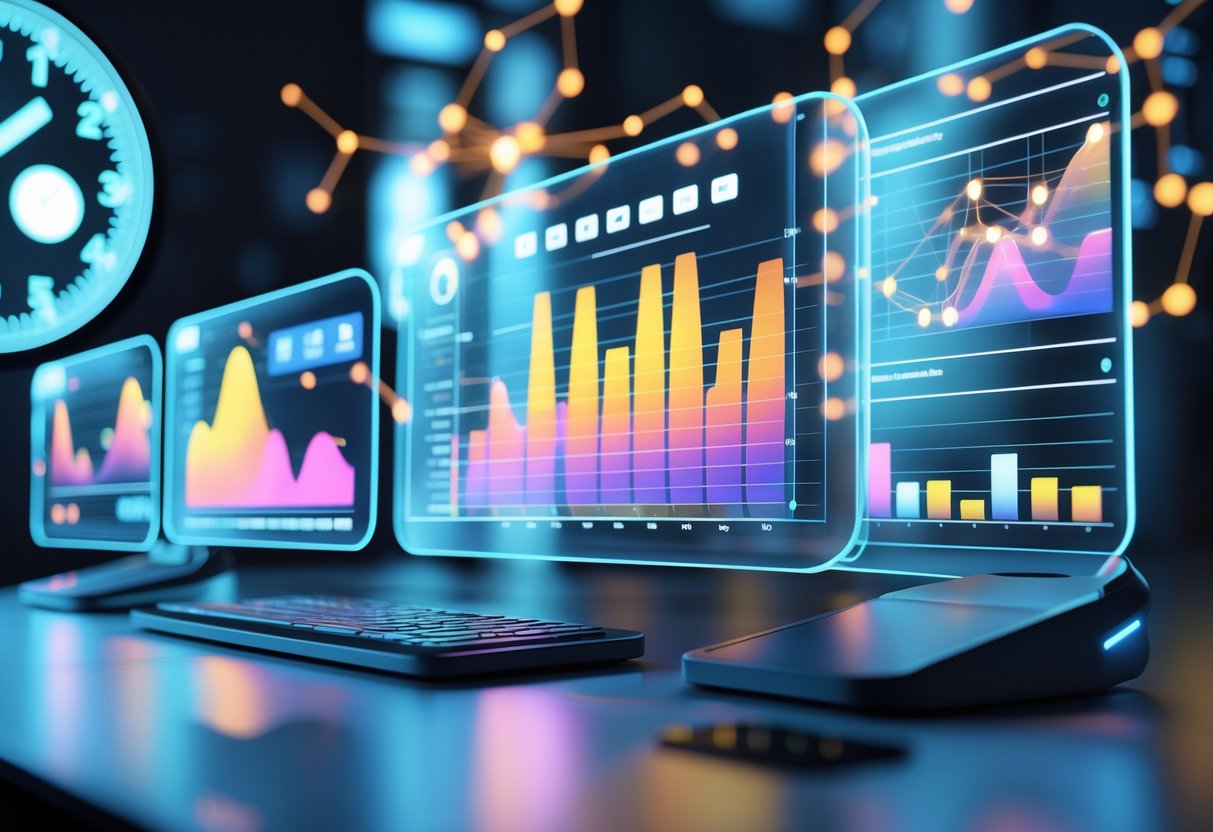
Tracking your posts’ performance at different times helps you spot the best moments to reach people. If you monitor regularly, you’ll see which patterns boost engagement and which fall flat.
Setting KPIs for Timing
You need clear goals to see if your posting times actually work. The best KPIs focus on engagement, not just reach.
Key metrics to track:
- Engagement rate per post – likes, comments, shares divided by followers
- Click-through rates – how many people click your links
- Response time – how quickly people engage after posting
- Peak activity windows – when most interactions happen
Set targets for each metric. Maybe aim for 5% engagement during peak hours and 2% off-peak.
Track these numbers weekly. Daily stats bounce around too much to show real trends.
Don’t focus just on follower count. A small, active audience is better than a huge group that never interacts.
Tracking Performance Over Time
It takes at least 3-4 weeks to spot real engagement trends. Social media behaviour shifts with seasons, news, and events.
Start with built-in platform analytics. Instagram Insights, Facebook Analytics, and Twitter Analytics all show timing data pretty clearly.
Weekly tracking schedule:
- Monday: Review last week’s post performance
- Wednesday: Check for mid-week engagement trends
- Friday: Plan next week’s posting times
Look for patterns across content types. Videos might do better at different times than text-only posts.
Keep a simple spreadsheet with post time, content type, and engagement rate. Sometimes, this reveals trends your analytics dashboard misses.
Screenshot your best-performing posts with timestamps. This gives you a quick visual reference for future planning.
Refining Strategies Based on Results
Once you’ve collected enough data, adjust your posting schedule to match how your audience behaves. Even small tweaks can make a big difference in engagement.
Test new post times slowly. Move your main posts 30 minutes earlier or later each week and see what happens.
Common adjustments that work:
- Post on weekends 2-3 hours later than weekdays
- Share visual content around lunch (12-2 PM)
- Drop news updates early (7-9 AM)
- Post entertainment content in the evening (6-8 PM)
If your engagement suddenly drops, check for outside factors. Holidays, big news, or algorithm changes can mess with everyone’s numbers.
Many esports creators notice their audience is most active during evening gaming sessions, not business hours. It’s worth testing your own followers’ habits instead of sticking to generic advice.
Review your strategy every month. What works in January could flop by June as your audience’s routines shift.
Common Timing Mistakes to Avoid
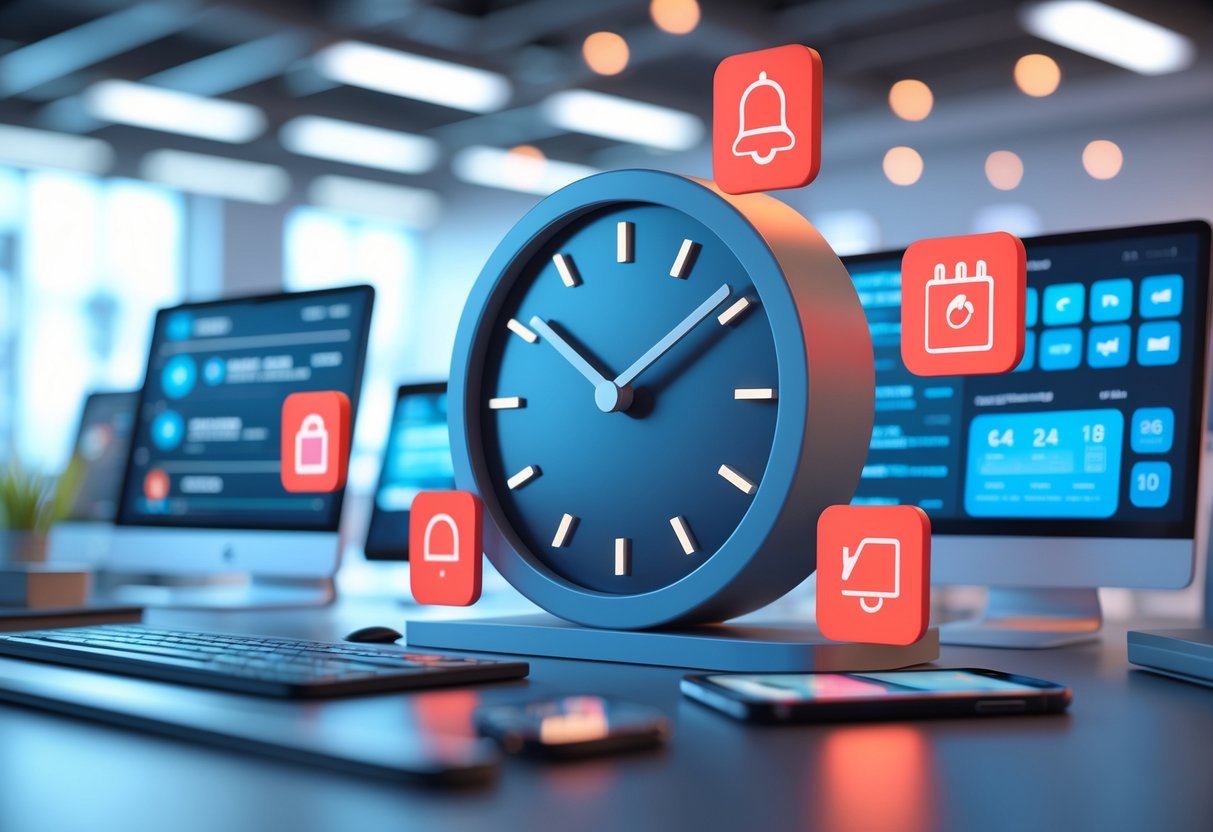
Even seasoned social media managers slip up with timing and lose half their engagement—or more. The biggest mistakes? Posting when nobody’s around, ignoring global followers, and flooding people’s feeds with too much content.
Posting During Low Activity
A lot of brands post during their own office hours instead of when their audience is online. It’s an easy way to waste good content.
We see companies schedule posts for 9 AM because that’s when the marketing team starts work. Meanwhile, their audience might be scrolling at 7 PM after dinner.
Check your analytics first. Most platforms tell you when your followers are online. Instagram’s Creator Studio and Facebook’s Page Insights make it easy.
Try out different time slots for two weeks. Share the same type of content at 10 AM, 2 PM, and 8 PM. See which gets the most interaction.
Gaming brands often post Saturday mornings, but their audience is probably still asleep. Evening posts usually get 40% more engagement.
Set up notifications for when your competitors post. If everyone’s posting at the same time, experiment with posting an hour earlier or later to stand out.
Neglecting Time Zone Differences
UK brands with US followers often post at noon and then wonder why engagement tanks. Your 12 PM post hits Americans at 4 AM.
Use scheduling tools like Buffer or Hootsuite to post at the best times for each region. If half your followers are in the US, schedule one post for UK peak hours and another for US evenings.
Check your follower locations in your analytics dashboard. Instagram shows your top cities and countries.
Try the “follow the sun” approach. Post when your biggest audience group is active, then repost or share similar content 8-12 hours later for other time zones.
For example, a London esports team with American fans can share match highlights at 6 PM UK time, then again at 11 PM (6 PM Eastern US).
Don’t assume everyone’s on the same schedule. Weekend timing can be totally different in other countries.
Overloading Your Audience
Posting too often—even at the right times—burns people out. They start ignoring your posts or unfollowing you.
Space your posts out. Most experts suggest 1-2 posts per day on Instagram and Facebook, 3-5 on Twitter, and 15-30 pins daily on Pinterest.
Watch your engagement rates. If likes and comments drop after you post more, you’re probably overdoing it.
Gaming accounts sometimes spam during tournaments or launches. This usually backfires, because algorithms notice the drop in engagement and show your stuff to fewer people.
Plan your posts with a content calendar. One quality post per day beats five so-so ones.
Listen to your audience. If people complain about too many posts or you see more unfollows on heavy days, cut back.
Every post competes with your last one in the feed. Three average posts won’t perform as well as one really strong post that grabs attention.
Future Trends in Social Media Timing
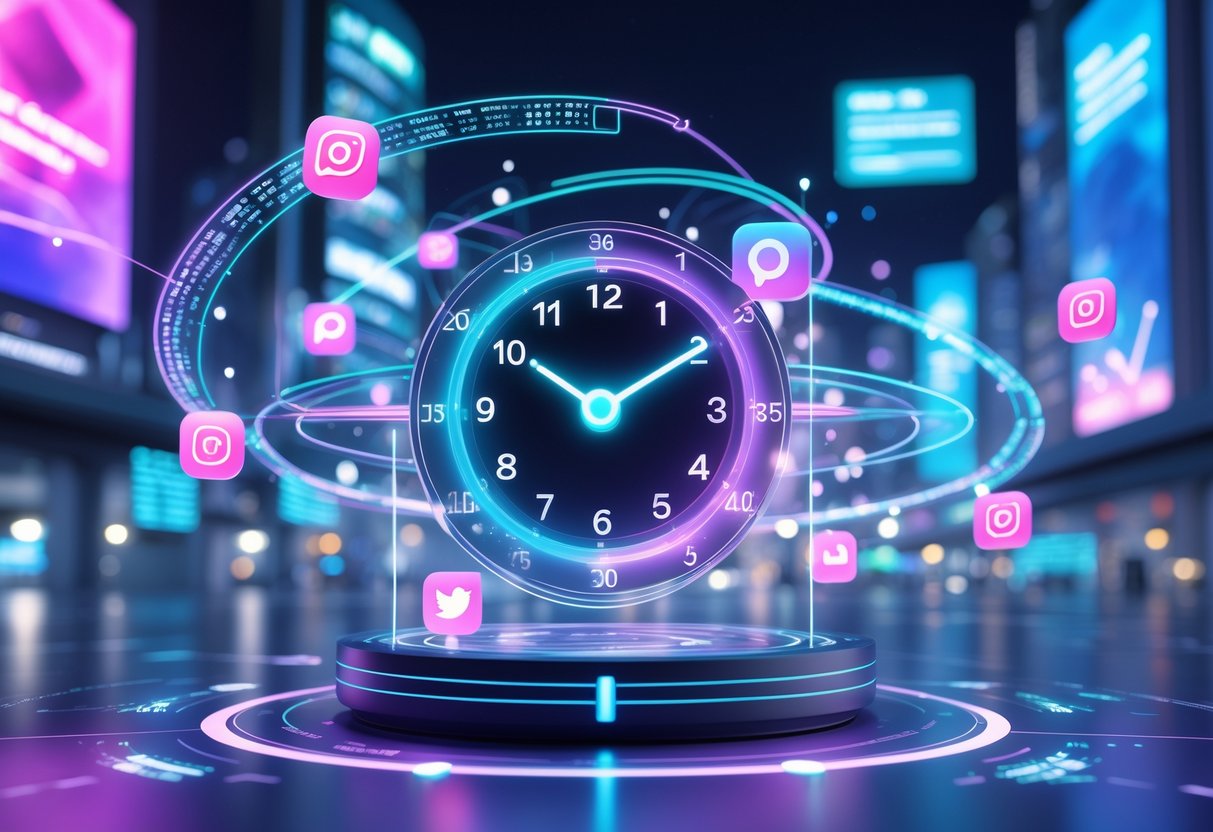
AI-powered tools are changing how we schedule content. Personalisation based on user behaviour is opening up new ways to time posts more precisely. Platform algorithms keep shifting, so timing strategies get more complex—but the rewards can be bigger too.
The Rise of AI-Powered Scheduling
AI-driven scheduling tools are shaking up social media timing. These systems scan millions of data points in real time to guess the best posting windows.
Modern tools like Later and Hootsuite use machine learning now. They look at your audience’s past engagement to suggest personalised posting times. It’s more than just adjusting for time zones.
The tech factors in things like:
- When each follower is active
- How different content types perform
- Recent algorithm changes
- Seasonal engagement shifts
AI predictions keep getting better. The system learns from every post and tweaks its future suggestions. You don’t have to keep testing manually.
Real-time adjustments are becoming normal. If engagement drops, AI tools can recommend new posting times within hours.
Personalisation Based on Behavioural Data
Behavioural data is replacing generic timing tips with insights tailored to your audience. The old “post at 9 AM” advice is fading fast.
Micro-timing is the new trend. Instead of broad hourly windows, tools now suggest 15-minute slots when your audience is most active. They track behaviour across touchpoints to get this precise.
Advanced analytics look at:
- How fast people comment
- Story completion rates
- Video watch time by post hour
- Engagement patterns across platforms
Geographic personalisation is getting smarter. Tools factor in not just time zones but cultural habits. For example, lunch breaks happen at totally different times in different countries.
The data shows engagement windows are more fragmented now. Remote work has created lots of mini-peaks instead of just morning and evening rush hours.
New Platform-Specific Timing Trends
Each platform is developing its own timing quirks. Generic timing advice doesn’t cut it anymore.
TikTok’s algorithm cares more about consistency than perfect timing. Lately, posting at the same time every day beats chasing peak hours. The platform rewards creators who stick to a schedule.
Instagram is moving towards earlier posts. Posts between 3-6 AM often outperform afternoon ones. There’s less competition in those early hours.
LinkedIn is getting busier outside business hours. Weekend activity is up as networking gets more casual. Industry content does well on Saturday mornings now.
Threads timing is still evolving. Early users see results with classic Twitter timing, but this might change as the platform finds its groove.
Platform-specific scheduling tools are now a must. Each platform’s algorithm is unique, so you need tailored tools for the best results.
Frequently Asked Questions
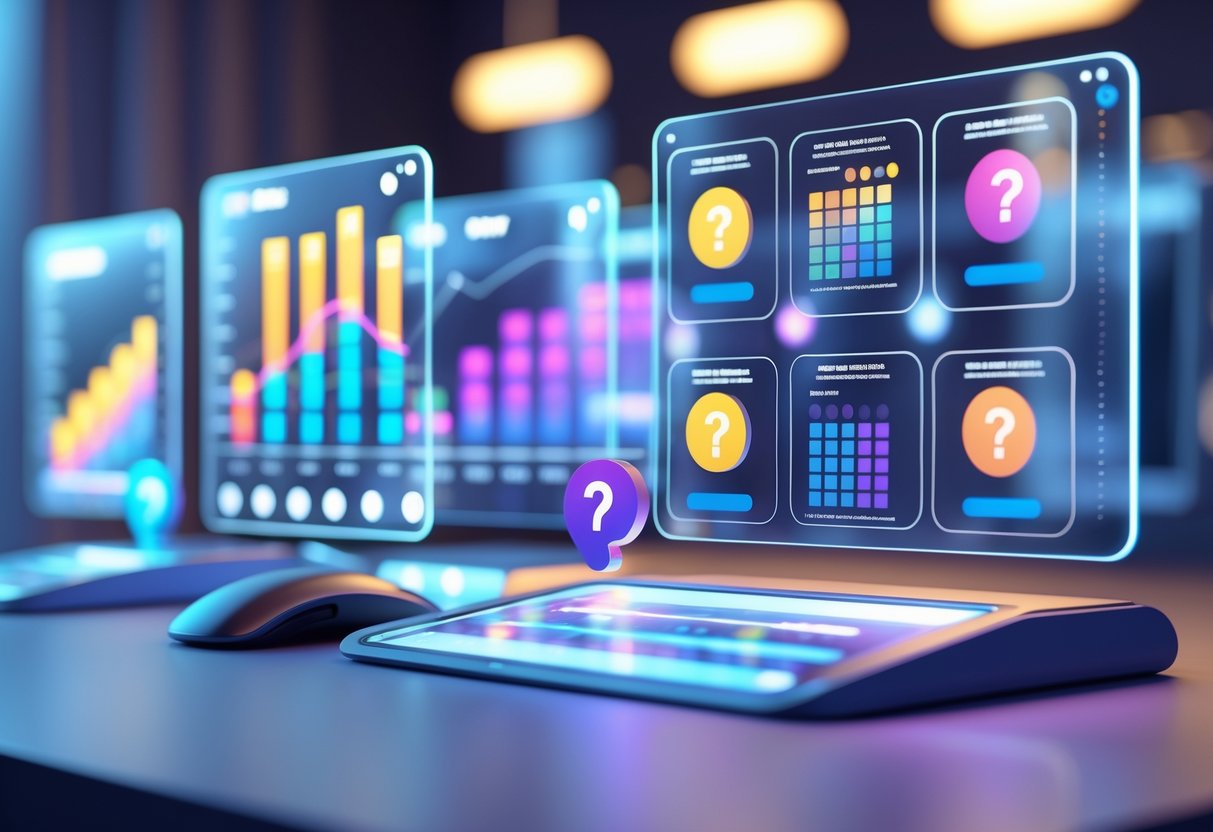
Post timing impacts engagement rates differently on each platform. Instagram likes mornings and evenings, TikTok performs well all day, and LinkedIn peaks during work hours. Your audience’s habits and location matter more than any “best time” chart.
What are the peak hours for sharing content on Instagram to maximise engagement?
Instagram engagement is highest between 7 AM and 9 AM, when people check their phones before the day starts. Posting early puts your content at the top of feeds before the algorithm buries it.
From mid-morning to early evening (up to 4 PM), you’ll still see steady engagement. People browse during breaks and commutes.
Weekend posts work most of the day, except in the very early morning or late at night. People scroll more casually on weekends.
Try different time slots within these ranges to see what your audience prefers. Your followers might not follow the crowd.
Could you suggest the optimal time frame for posting on various social media platforms?
Facebook tends to get the most traction between 7 AM and 9 AM on weekdays. You’ll notice engagement stays pretty steady all week, so sticking to a regular schedule feels doable.
LinkedIn comes alive during business hours, especially from 10 AM to 4 PM on Tuesday, Wednesday, and Thursday. I’d skip weekends—your professional crowd is probably not thinking about work then.
TikTok acts a bit like Instagram, doing well in the early morning, mid-morning, and afternoon. But honestly, the algorithm cares more about content quality than the exact time you post.
X (yeah, Twitter) really wakes up around 11 AM and again during lunch, from 1 PM to 3 PM. Posting a few times a day helps you stay visible, since the feed moves lightning fast.
YouTube’s best timing depends on what you’re sharing. Short videos follow Instagram’s pattern, but long-form content gets more views in the evenings or on weekends when people have extra time.
Is there an ideal day of the week to share posts for better visibility on social media?
Tuesday through Thursday usually get the most engagement for B2B or professional posts on LinkedIn and X. Those mid-week days just seem to catch people when they’re working and paying attention.
Monday mornings can work for LinkedIn if you’re pushing business services or trying to set up calls. People often plan out their week then.
Weekends lean heavily toward B2C stuff on Instagram, TikTok, and Facebook. Folks have more downtime to scroll and interact with entertainment or lifestyle posts.
If you’re posting business-focused content, avoid weekends. The professional crowd checks out from work content during their time off.
Friday evenings suit entertainment platforms, but LinkedIn? Not so much. Try to match your post to when your audience is actually in the mood for it.
How does the engagement rate vary with posting times on TikTok?
TikTok keeps engagement pretty consistent throughout the day, more so than other platforms. The algorithm really cares about quality and whether people stick around—not so much about when you post.
Early mornings (7 AM to 9 AM) catch people doing their first scroll of the day. This lines up with Instagram’s sweet spot, too.
Afternoons, especially between 1 PM and 4 PM, work well since people take breaks and check their phones. Engagement doesn’t really dip much here.
Evenings bring in strong numbers as people unwind after work or school. You’ll see a lot of users logging on to relax.
Try out different time slots instead of obsessing over the “perfect” one. TikTok likes consistency and quality above all.
What factors should be considered when deciding what time to post for increased likes on Instagram?
Where your audience lives matters more than any blanket advice. Dive into Instagram Insights and check when your followers are actually online.
The kind of content you post changes things, too. Business posts do better in the morning on weekdays, while lifestyle stuff shines in the evenings and on weekends.
Your industry makes a difference. Fashion and lifestyle brands often crush it with evening posts, but productivity content tends to do best in the morning.
Consistency is more important than nailing the “perfect” time. Regular posting at good times beats random posts, even if they’re at supposedly optimal moments.
Keep an eye on your analytics every week. Your followers might have habits that totally ignore the averages.
Does the best time to post content change for different types of social media audiences?
B2B audiences usually check in during working hours on professional platforms. They just don’t engage much with business content in the evenings or over the weekend.
B2C audiences? They’re a bit more flexible with timing, but most people still want entertainment content during their downtime. Evenings and weekends tend to see more activity.
If you’re dealing with global audiences, you’ll probably need to post at several different times. One post just won’t reach everyone in all those time zones.
Age plays a role too. Younger folks might scroll through feeds later in the day. On the other hand, older users stick to more traditional hours.
Different industries bring their own quirks. Gaming content seems to pop off in the evenings. Fitness content, though, often does best in the early morning.
Think about your content goals as well. If you’re after leads, try posting during business hours. For brand awareness? Leisure times could be your sweet spot.

